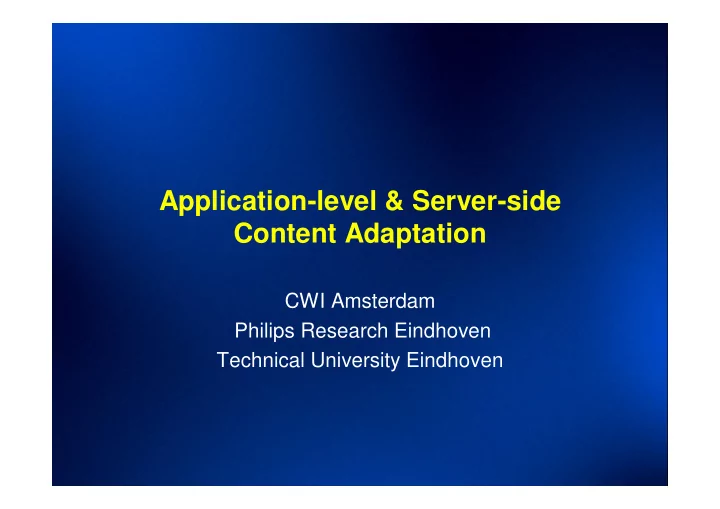

Application-level & Server-side Content Adaptation CWI Amsterdam Philips Research Eindhoven Technical University Eindhoven
Hypermedia presentation adaptation • Adaptation to address differences in – Network, platform, user • Several aspects of the presentation can be adapted – content (media items) – space (visual layout) – time (temporal order, orchestration and synchronization) – interaction (including navigation design) • Different strategies – top-down (goal-driven) vs. bottom-up (data-driven) – client-side (SMIL) vs. server-side (Hera, Cuypers)
Talk Overview • Example application: Electronic Program Guide – Presentation personalization using XML/XSLT (Philips) • Adaptive querying and retrieval – RMM & slices (TUE) • Adaptive multimedia presentation generation – Cuypers presentation engine: rhetorics & constraints (CWI) – SMIL 2.0 for multimedia delivery (CWI, Philips, Oratrix)
Example: adaptive EPG (Philips) • Separate data from presentation – Separation of the structure of electronic program guide information from its presentation format – Not limited to EPG data • Adaptation – Customisation to different platforms (TV, PC, RC) – Personalization through personal profiles – New user interfaces (presentation styles) can easily be added or removed • Implementation – XSL/XSLT for transforming XML into Web presentation formats
Architecture
Style sheet adaptation
Different machines, different looks...
Performance analysis XSLT complex style sheet XML simple style sheet
Evaluation • XML/XSL can be used to present well-defined program information on a wide-range of CE devices • XSL/XSLT only works for domains whose structure can be well-defined by a DTD/Schema – different solutions needed for presenting information retrieved from the Web • XML parsing and XSL processing of large EPG documents in memory is time-consuming for large XML documents – XSL is not meant for and should certainly not be used as a selection mechanism for retrieving items
Adaptive querying and retrieval (TUE) • Goal of the Hera system is to develop a generic WIS (Web Information System) that: – Supports queries to semi-structured data – Integrates heterogeneous data sources – Facilitates presentation adaptation • Current demo focuses on data adaptation
Hera demo (data adaptation) SQL Query builder MySQL Data retrieval JDBC M-slices (RMM) Slice packaging HTML Presentation generation
Slice diagram (extension of ER) Entity Agency Attribute address owns Relationship House House Info Main Houses Slice Index
Future • Query/transformation language for semi-structured data • Heterogeneous data sources – relational databases – object-oriented databases – XML repositories – ... • Presentation adaptation – Data (partially already done at slice level) – Navigation – Integration with Cuypers
Cuypers Generation Engine (CWI) • Multimedia document manipulation differs from text because multimedia – uses different document and presentation abstractions – formatting is not based on text flow – transformations need feedback from the formatting back-end – transformations are hard to describe in a functional language. • Cuypers is based on – media independent presentation abstractions – transformation rules with built-in • backtracking • constraint solving
Cuypers Conceptual Layering
Cuypers Web embedding
Opportunities for demonstrator • server/client-side adaptation to network resources – exploit QoS functionality of RTIPA network testbed • server-side engine generates SMIL 2.0 – combined Hera/Cuypers approach • client-side adaptation by Oratrix SMIL 2.0 player – adaptive multimedia authoring/playback support by GR i NS • both client and server need a network API – query network interface for info about bandwidth, latency etc – call-back notification service for significant changes – interface for fine-grained manipulation of TOS settings/packet colouring – ...
Wrap up • Server-side generation and adaptation needs sophisticated database support – Efficiency: XSLT is not a query language – High-level and adaptive view to different sources • Multimedia transformation differs from text – other layout rules – other abstractions – other tools • Client-side adaptation – need for standardised clients – need for authoring support – See Dick Bulterman’s talk
Recommend
More recommend